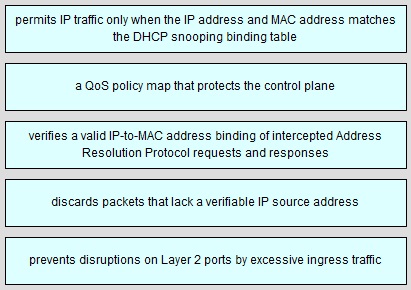- All Exams Instant Download
Drag the security description on the left to the appropriate security feature on the right
DRAG DROP
Drag the security description on the left to the appropriate security feature on the right.

Answer: 
Explanation:
IP Source guard: IP Source Guard provides source IP address filtering on a Layer 2 port to prevent a malicious host from impersonating a legitimate host by assuming the legitimate host’s IP address. The feature uses dynamic DHCP snooping and static IP source binding to match IP addresses to hosts on untrusted Layer 2 access ports.
Initially, all IP traffic on the protected port is blocked except for DHCP packets. After a client receives an IP address from the DHCP server, or after static IP source binding is configured by the administrator, all traffic with that IP source address is permitted from that client. Traffic from other hosts is denied. This filtering limits a host’s ability to attack the network by claiming a neighbor host’s IP address. IP Source Guard is a port-based feature that automatically creates an implicit port access control list (PACL).
CoPP: Control Plane Policing (CoPP) introduced the concept of early rate-limiting protocol specific traffic destined to the processor by applying QoS policies to the aggregate control-plane interface. Control Plane Protection extends this control plane functionality by providing three additional control-plane subinterfaces under the top-level (aggregate) control-plane interface. Each subinterface receives and processes a specific type of control-plane traffic.
Dynamic Arp Inspection: Dynamic ARP inspection is a security feature that validates ARP packets in a network. It intercepts, logs, and discards ARP packets with invalid IP-to-MAC address bindings. This capability protects the network from certain man-in-the-middle attacks.
Dynamic ARP inspection ensures that only valid ARP requests and responses are relayed. The switch performs these activities:
• ![]()
Intercepts all ARP requests and responses on untrusted ports
• ![]()
Verifies that each of these intercepted packets has a valid IP-to-MAC address binding before updating the local ARP cache or before forwarding the packet to the appropriate destination
• ![]()
Drops invalid ARP packets
Unicast RPF: The Unicast RPF feature reduces problems that are caused by the introduction of malformed or forged (spoofed) IP source addresses into a network by discarding IP packets that lack a verifiable IP source address. For example, a number of common types of Denial-of-Service (DoS) attacks, including Smurf and Tribal Flood Network (TFN) attacks, can take advantage of forged or rapidly changing source IP addresses to allow attackers to thwart efforts to locate or filter the attacks. Unicast RPF deflects attacks by forwarding only the packets that have source addresses that are valid and consistent with the IP routing table.
When you enable Unicast RPF on an interface, the device examines all ingress packets received on that interface to ensure that the source address and source interface appear in the routing table and match the interface on which the packet was received. This examination of source addresses relies on the Forwarding Information Base (FIB).
Traffic Storm Control: A traffic storm occurs when packets flood the LAN, creating excessive traffic and degrading network performance. You can use the traffic storm control feature to prevent disruptions on Layer 2 ports by a broadcast, multicast, or unicast traffic storm on physical interfaces.
Traffic storm control (also called traffic suppression) allows you to monitor the levels of the incoming broadcast, multicast, and unicast traffic over a 1-second interval. During this interval, the traffic level, which is a percentage of the total available bandwidth of the port, is compared with the traffic storm control level that you configured. When the ingress traffic reaches the traffic storm control level that is configured on the port, traffic storm control drops the traffic until the interval ends.
Latest 300-165 Dumps Valid Version with 328 Q&As
Latest And Valid Q&A | Instant Download | Once Fail, Full Refund
Subscribe
Login
0 Comments
Inline Feedbacks
View all comments

